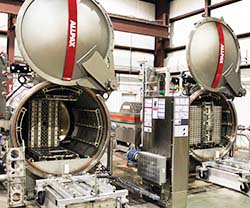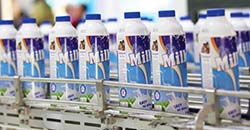The Evolution of Thermal Processing
PROCESSING
 Thermal processing is still the reliable work horse of food preservation, dating back to Napoleonic times when Nicolas Appert developed a method for preserving food in sealed glass jars. Later others developed metal cans for the same purpose, but it was almost another century before there was a scientific understanding of why heating and the exclusion of air worked as it did. In the meantime, canning was a haphazard technology with frequent failures.
Thermal processing is still the reliable work horse of food preservation, dating back to Napoleonic times when Nicolas Appert developed a method for preserving food in sealed glass jars. Later others developed metal cans for the same purpose, but it was almost another century before there was a scientific understanding of why heating and the exclusion of air worked as it did. In the meantime, canning was a haphazard technology with frequent failures.
Louis Pasteur observed that yeasts were responsible for fermentation of grape juice to wine and that other microscopic organisms were responsible for spoilage of foods. Ultimately, it was understood that thermal processing was killing vegetative microbes and the spores of other spoilage and pathogenic bacteria.
Several forms of thermal processing have evolved. They include post-filling, hot fill, continuous flow, and aseptic.
In addition, there are many ways to deliver the thermal energy that kills microbial cells and spores. Among these approaches are convection, conduction, radiation, ohmic, and radio frequency and microwave.
These paths and forms can be combined in various ways to produce a large number of distinct processes. All are governed, however, by the same fundamental kinetics.
Thermal Resistance of Microorganisms
The rate at which microbes die when subjected to elevated temperatures is considered empirically to be a first order rate process, which means that when the logarithm of surviving numbers are plotted against time at constant temperature, the result is mostly a straight line. Straight lines are convenient for simple mathematical models. The data are mostly a straight line, as distinct from exactly a straight line, because of various complexities, such as activation of dormant spores, mixed cultures (each strain of a microbe has distinct rate characteristics, so a mixture will show some mathematical average), and finite heat transfer rate, even in the small test tubes typically used in such experiments.
The reciprocal of the slope of the straight line best representing the data is called the decimal reduction time, D, and is the time in minutes to reduce microbial count by a factor of 10 at a given temperature.
Decimal reduction times decrease as temperature increases. This effect is measured by determining the death rates at various temperatures and plotting the results again on a semi-logarithmic graph. The number of degrees needed to change the decimal reduction time by a factor of 10 is the temperature sensitivity, z. It is important to express which temperature scale is used for z—Fahrenheit or Celsius.
Given z and D at some reference temperature, D at any other temperature can be calculated. It is common to use 250°F as reference for low-acid foods, and 200°F for high acid foods. Why should that matter?
The microorganism of concern for low-acid foods (pH > 4.6) is Clostridium botulinum, a facultative, spore-forming microbe that can produce, under the right conditions, a very potent toxin. The right conditions are as follows: pH > 4.6, water activity above 0.85, temperature above 40°F, and the absence of oxygen. These are precisely the common conditions in hermetically sealed containers of foods based on meat and vegetables. (Fruits typically have natural pH < 4.6.)
All of the various thermal processes are governed by the same kinetic mechanisms, but may differ in how energy is delivered and then how temperature is distributed.
--- PAGE BREAK ---
Heat Transfer
Thermal processing relies on heating food to a temperature adequate to kill spores and vegetative microbes that are pathogens or spoilage causes. Depending on the specific process, how this is accomplished varies. Heat transfer by conduction or convection relies on a temperature driving force equal to the difference in temperature between a source, such as steam, and a sink, such as a package of food. The temperature within a package of food, such as a can, jar, or pouch, will vary depending on location and on the thermal properties of the contents.
To ensure that all portions of food in a container receive at least the minimal required combination of time and temperature, thermal processes are specifically concerned with the cold spot in a container. For conduction heating foods, that is those that are mostly solid, the cold spot is usually the geometric center of the container, but for more fluid foods that can circulate due to natural convection or because they are agitated, the cold spot may be slightly below the geometric center.
In flowing fluids, the corresponding area of concern is the fastest-moving portion of fluid, which is normally at the center of a pipe.
Heating rate by thermal radiation is proportional to the difference of the absolute temperatures raised to the 4th power. Absolute temperature is equal to degrees F plus 460 or degrees C plus 273. Heating by radiation is effective for sterilizing surfaces, but bulk heating of the interior of a package or piece of food is by conduction or convection from the surface inwards.
Heating by electromagnetic radiation (microwave or radio frequency) is less dependent on temperature and, instead, relies on the dielectric properties of food. Radiation at the frequencies normally used cannot penetrate metal, so foods must be in plastic or glass containers or flow through pipes for such heating to be effective. One recently developed process uses a combination of hot water and microwaves to sterilize low-acid foods in plastic containers, while another new process uses a continuously flowing stream through a microwave cavity to sterilize pumpable foods.
Ohmic heating relies on the electrical resistance of a food to generate heat throughout the material. Ohmic heating involves passing an electric current through flowing fluid food. Like microwave or radio frequency, ohmic heating is normally faster than conventional heating through the walls of a container or pipe.
--- PAGE BREAK ---
Why Does Heating Rate Matter?
Just as heating can kill microbes and spores, heating can impact other characteristics of foods, not always in a favorable way. Heating can destroy nutrients, such as some vitamins. It can also change texture by toughening or softening meats and vegetables, modify color, and accelerate chemical reactions that impact flavor. Taken together, we call this cooking. Some amount of cooking is often necessary to make foods edible, but too much can reduce palatability.
Cooking is hard to quantify, so often a proxy for cooking is chosen, such as thiamin destruction, texture change, or color change. Rates of change with temperature can then be modeled much as microbe destruction is. Generally it is found that the temperature sensitivity of cooking, however it is measured, is greater than that of microbial destruction (z for cooking is greater than z for microbial kill). One consequence is that high temperatures for short times are usually better for retaining sensory quality than are lower temperatures for longer times, providing equivalent microbial reductions.
Microbial reductions are often expressed as multiple decimal reductions, for instance 12 D for C. botulinum and 5 D for most other pathogens.
Another way to optimize thermal processing for quality retention is to reduce the distance over which heat must be transferred. This is the motivation driving the development of flexible pouches and low-profile trays. The rate of heat transfer, exactly for conduction and approximately when there is some convection, is proportional to the square of the distance from the surface to the center. Thus there is a large reduction in required heating time when this distance is reduced.
Flexible pouches pose an interesting challenge because they can expand when the contents are heated due to the residual gas inside. To maintain proper control of heating rate, pouches must be restrained during heating.
Internal pressure also poses a potential problem for glass and plastic containers. Once the target internal temperature is achieved, containers are cooled by contact with cold water. At that point, heat transfer is reversed, and the interior is now hotter than the surface. If pressure is not applied to the containers, they might burst or develop leaks in seals because plastics soften at high temperatures. Thus during cooling of low-acid foods in containers, over pressure is provided.
 Aseptic processing is a specific thermal process in which fluid foods and containers are sterilized separately. After receiving an appropriate time and temperature treatment, the food is cooled and filled into the sterile container in a sterile atmosphere. The compelling advantage of aseptic processing is the ability to use inexpensive containers and the opportunity to optimize the thermal treatment of the food without the limitations imposed by containers.
Aseptic processing is a specific thermal process in which fluid foods and containers are sterilized separately. After receiving an appropriate time and temperature treatment, the food is cooled and filled into the sterile container in a sterile atmosphere. The compelling advantage of aseptic processing is the ability to use inexpensive containers and the opportunity to optimize the thermal treatment of the food without the limitations imposed by containers.
Containers that are filled aseptically include the familiar juice boxes formed from laminates of paper, aluminum foil, and plastic film; lightweight plastic bottles and tubs; large metal cans for foodservice that would require very long cooking times in retorts; flexible pouches up to 300 gal; and even million-gallon tanks. Each may be sterilized a different way: laminates are sterilized with chemicals, usually hydrogen peroxide; plastic containers may be sterilized by the heat of forming them or by chemicals; large pouches are sterilized by ionizing radiation; and large tanks are sterilized by iodoforms that need not be rinsed.
Fluid foods are sterilized in scraped surface heat exchangers, triple tubes, or by direct steam injection.
 J. Peter Clark, Ph.D., CFS, Contributing Editor,
J. Peter Clark, Ph.D., CFS, Contributing Editor,
Consultant to the Process Industries,
Oak Park, Ill.
[email protected]
